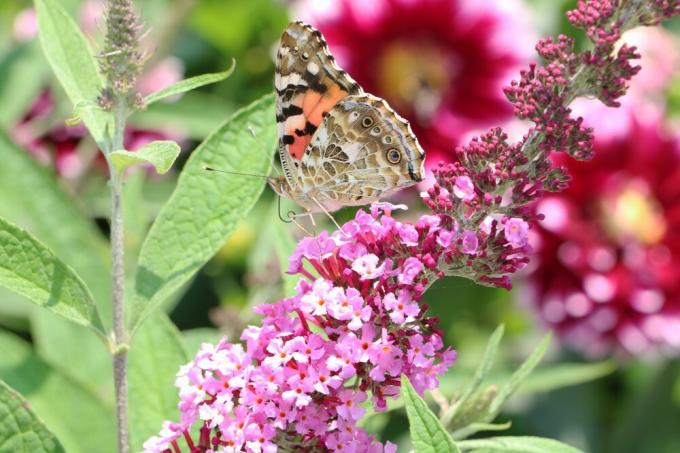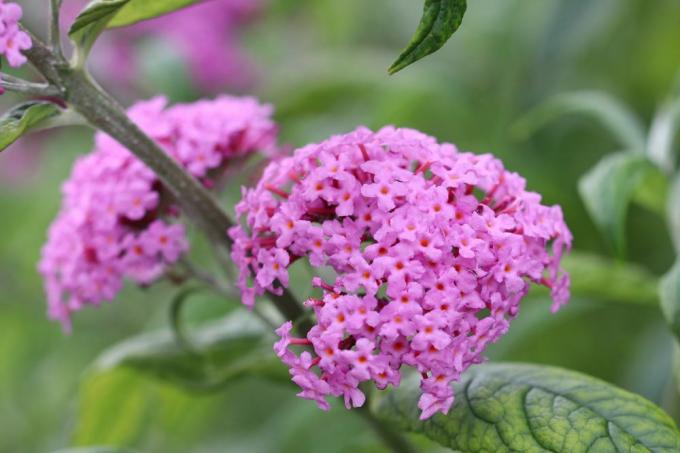
table of contents
- Planting butterfly lilacs
- Planting time
- preparation
- Winter protection
- Plant butterfly lilacs in the tub
- Plant spacing
Butterfly lilac, also known as buddleia, enchants many gardens from July to October into a splendidly blooming paradise. The long panicles of flowers appear in a colorful sea of flowers from white to light pink, red to lavender and dark purple. As the name suggests, the scent and nectar of the flowers attract many colorful butterflies. Buddlejas are extremely robust, easy to care for and fast growing. The right time to plant and the planting technique largely determine the duration of the flowering period.
Planting butterfly lilacs
The trade mainly offers butterfly lilacs as container goods. Buddleja davidii, probably the best-known variety of buddleia, is widespread and very popular. It is very robust with an abundant abundance of flowers and is also considered the original species of all Davidii hybrids.
Planting time
These so-called container goods can in principle be planted during the entire vegetation period, provided the soil is frost-free. However, the planting of butterfly lilacs is in the spring after the ice saints, from 15. May be preferable. At this time late frosts are normally no longer to be expected, as butterfly lilacs, especially young plants, are sensitive to frost. The bushes then have enough time to grow well in the new location by winter and accordingly develop a good and healthy root system.
Of course, new planting is also possible in early autumn. At this point in time, the earth is still well warmed down to the depths, which has a positive effect on the roots of the plants. The planting should then take place from September to mid-October. The process is then completed before the onset of winter even if the weather is good, so that the Buddleia can survive the winter without major damage. However, it is advisable to provide newly planted shrubs with winter protection. The frost hardiness at Buddleja only increases over the years.
A new planting in midsummer should be avoided. Because it can get quite dry due to the weather. Of course, regular watering can help. However, the time and the conditions for root formation are not exactly ideal.

Note: The butterfly lilac is an invasive neophyte. It spreads very quickly through seeds and displaces other plants in the process. Therefore, faded panicles should be kept constantly cut off will.
preparation
Not only the planting time is responsible for good growth and abundance of flowers, but some preparations must be made before each planting, regardless of whether it is spring or autumn:
- right one Choice of location
- warm, sheltered, sunny to partially shaded place
- moderately dry, nutrient-rich, humus-rich, loose soil
- slightly acidic to alkaline pH
Furthermore, the soil and the shrub must be carefully prepared regardless of the time of planting:
- Soak the root ball thoroughly in water
- sufficient if no more bubbles rise
- Dig the planting pit twice as large and deep as the root ball
- Loosen the earth properly in the pit
- if necessary, add a drainage layer made of gravel or sand
- Mix the excavated earth with compost and horn shavings
- Do not insert the plant deeper than before
- Fill in the earth and step on it
- water abundantly
- with new plantings at least 20 liters of water
Winter protection
Sufficient winter protection is necessary, especially when planting in autumn. However, this is not entirely true, because in principle all young butterfly lilacs need protection in winter for the first two to three years. They are still very sensitive to frost. They are then hardy only with increasing age. The root area needs special protection. It is simply covered with a thick layer of leaves or straw. In addition, spruce twigs can be placed on top. If necessary, it is possible to stretch a fleece over the above-ground parts of the plant.
Plant butterfly lilacs in the tub
There are also various dwarf species with a height of up to 150 centimeters. These are particularly suitable for planting in pots. The growth is more compact with dense branches. With good care, these shrubs can remain in the pot for many years. There is no planting distance to consider here, but the size of the tub and the planting itself are decisive:
- Bucket diameter at least 70 to 80 cm
- Bucket height 60 to 70 cm
- Put in a drainage layer, then special potting soil
- Regular watering after planting
- Winter in a frost-free room below 10 ° C
- alternatively, protect the pot with fleece
Summer lilacs are a particular eye-catcher as a solitary planting in a lawn. There is no significant planting distance to keep when planting, as it stands alone. The situation is different with group plantings or with planting in the perennial bed. Depending on the variety, a distance of 100 to 150 centimeters to other plants should definitely be maintained.

tip: In order to curb the urge to spread of the lilac, it is advisable to use a rot-proof root barrier in the planting pit. Alternatively, a large masonry tub without a bottom can also be used.
Plant spacing
Butterfly lilac shows quite extensive growth. Depending on the variety, the plant can reach a height of up to 400 centimeters. The width of the bushes is also very impressive at 250 centimeters. The growth per year varies between 30 and 150 centimeters. The colorful flower spikes alone reach a length of 30 centimeters. Here you can already see that Buddleja needs a correspondingly large space in the garden.
Plant spacing when planting hedges
The Buddleja davidii variety is particularly suitable for a fragrant hedge as a privacy screen. The buddleia plants can reach a height between three to four meters. Planting should be done in spring when the soil is frost-free and frosts are no longer to be expected. The butterfly lilac can also be planted in autumn in wine-growing areas. For an extremely opaque hedge, it is advisable to plant Buddleja davidii in two rows offset from one another. However, sufficient space is required to maintain the appropriate planting spacing, so that a good development of the plants is guaranteed.
- in the first row distance between plants 70 cm
- Distance between the first and second row: 90 to 100 cm
- Always place bushes on a gap
- Planting distance within the second row 70 cm
Of course, such a hedge should create protection from the prying eyes of the neighbors. But beware! When planting, it is essential to keep a distance to the property line. Otherwise disputes can quickly arise. The planting distances vary considerably from state to state. A regulation of the border distances when planting hedges, bushes and trees is regulated in the respective neighborhood law. City and municipal administrations can provide information.

tip: If there are no precise specifications, there is a rule of thumb: For trees, bushes and hedges Up to a height of 2 m, a limit distance of at least 50 cm applies, for taller plants at least 1 m.



